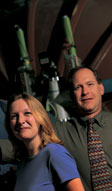 
Dawn
of a New Machine
A
gargantuan machine can trace carcinogens and other tiny particles
as they travel through living tissues.
But
for a small handful of now-indispensable machines, medicine as we
know it today would not exist: the microscope, which permitted discovery
of the cell; the hypodermic syringe, which made blood transfusion
possible; the x-ray, which allowed doctors to see inside the body
without cutting it open.
Now another new machine — the accelerator mass spectrometer,
or AMS — is again transforming medical science.
“It’s opened up a world for us equivalent to what the
microscope did for biologists,” said Ken Turteltaub, a toxicologist
and co-leader of the UC Davis Integrated Cancer Research Program’s
biomedical molecular oncology program.
The AMS counts atoms that have been “tagged” with carbon-14
or another radioactive isotope. Insert a small sample of blood or
tissue into the giant machine and it will tell you, within seconds,
whether the tagged substance you’re looking for — a
potential carcinogen, perhaps, or a chemotherapy drug — is
present. The AMS can detect a single tagged atom out of a quadrillion
(1,000,000,000,000,000).
This exquisite sensitivity enables scientists to measure exact levels
of a tagged substance in the tissues of living human beings, even
when only a faint trace of the substance is present.
  

Home |
Table of Contents |
To our Readers |
Building on Basics
Focusing on Patients |
In Translation |
First Steps
Campus Connection |
Benefactors |
News in Brief
UC Davis Health System |
© 2000, 2001, 2002 UC Regents. All rights reserved.
|
 |



 

Lawrence
Livermore scientists Karen Dingley and Ken Turteltaub conducted
some of the first human experiments using the accelerator mass spectrometer.
|


